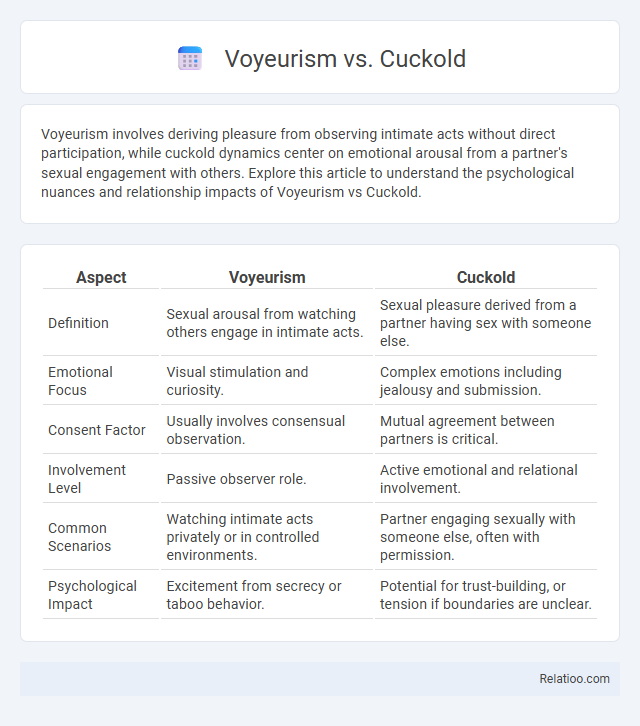Voyeurism involves deriving pleasure from observing intimate acts without direct participation, while cuckold dynamics center on emotional arousal from a partner's sexual engagement with others. Explore this article to understand the psychological nuances and relationship impacts of Voyeurism vs Cuckold.
Table of Comparison
| Aspect | Voyeurism | Cuckold |
|---|---|---|
| Definition | Sexual arousal from watching others engage in intimate acts. | Sexual pleasure derived from a partner having sex with someone else. |
| Emotional Focus | Visual stimulation and curiosity. | Complex emotions including jealousy and submission. |
| Consent Factor | Usually involves consensual observation. | Mutual agreement between partners is critical. |
| Involvement Level | Passive observer role. | Active emotional and relational involvement. |
| Common Scenarios | Watching intimate acts privately or in controlled environments. | Partner engaging sexually with someone else, often with permission. |
| Psychological Impact | Excitement from secrecy or taboo behavior. | Potential for trust-building, or tension if boundaries are unclear. |
Understanding Voyeurism: Definition and Key Traits
Voyeurism involves deriving pleasure from secretly observing others engaging in intimate or private activities without their consent, characterized by a desire for visual stimulation and often linked to secrecy and arousal from forbidden acts. In contrast, cuckoldry centers around consensual scenarios where one partner derives gratification from their partner's sexual interactions with others, emphasizing themes of trust, jealousy, and complex emotional dynamics. Understanding voyeurism requires recognizing its foundation in non-consensual observation, distinct from the consensual and relational components inherent in cuckolding.
What is Cuckold: Terminology and Context
Cuckold refers to a person, typically a man, whose partner engages in sexual activities with others, often with the knowledge and consent of the cuckold. This term originates from historical contexts where cuckoldry implied social stigma, but in modern usage, it is often part of consensual non-monogamous relationships or fetish communities. You should understand that cuckolding differs from voyeurism, which primarily involves watching others engage in sexual acts without participating or being directly involved.
Psychological Motivations Behind Voyeurism
Psychological motivations behind voyeurism often stem from a desire for control, arousal through observation, and forbidden pleasures, contrasting with cuckold dynamics that involve consensual humiliation and complex emotional bonds. Voyeurism centers on secretive watching for sexual gratification without direct involvement, driven by curiosity and anxiety relief. Understanding these distinct motivations clarifies the unique psychological profiles linked to voyeuristic behavior compared to cuckold fantasies.
The Dynamics of Cuckold Relationships
Cuckold relationships involve a consensual dynamic where one partner derives pleasure from watching their significant other engage intimately with another, distinguishing it from general voyeurism which focuses on observing without direct involvement. In cuckold dynamics, emotional and psychological elements like trust, communication, and negotiated boundaries play a crucial role in maintaining relationship stability. This contrasts with voyeurism's primarily visual gratification, emphasizing cuckold relationships' complex balance of power, desire, and consent.
Legal and Ethical Perspectives on Voyeurism
Voyeurism involves observing individuals without their consent, typically violating privacy and legal boundaries, whereas cuckoldry is a consensual relationship dynamic with no inherent legal issues. Legal frameworks categorize voyeurism as a criminal offense, with penalties including fines and imprisonment to protect personal privacy rights. Your understanding of voyeurism should emphasize its ethical implications, as non-consensual observation infringes on autonomy and can cause significant psychological harm.
Voyeurism vs Cuckold: Core Differences
Voyeurism involves deriving sexual pleasure from watching others without their knowledge or consent, primarily focusing on observation alone. Cuckold scenarios center on a consensual dynamic where one partner derives arousal from their significant other engaging sexually with someone else, emphasizing participation and emotional components. The core differences lie in consent, involvement, and the relational context, with voyeurism being covert and passive, while cuckolding is overt, consensual, and relationally complex.
Emotional Impact and Boundaries in Both Practices
Voyeurism involves deriving pleasure from watching others without direct involvement, often triggering feelings of thrill and secrecy, whereas cuckolding centers on consensual partner sharing, emphasizing emotional intimacy alongside erotic stimulation. Emotional impact in voyeurism can include excitement mixed with guilt or anxiety due to the taboo nature, while cuckolding often requires trust and clear communication to navigate jealousy and vulnerability. Your boundaries must be respected in both practices, with explicit consent and open dialogue essential to maintain emotional safety and mutual satisfaction.
Consensuality: Importance in Voyeurism and Cuckolding
Consensuality is paramount in both voyeurism and cuckolding, ensuring all parties willingly engage without coercion or deception. In consensual voyeurism, participants agree to observation boundaries that respect privacy and comfort, fostering trust and mutual pleasure. Similarly, consensual cuckolding relies on clear communication and established limits to maintain healthy relationships and emotional security among all involved.
Common Misconceptions and Stereotypes
Voyeurism is often misunderstood as purely predatory behavior, but it primarily involves consensual observation of sexual acts without participation, unlike cuckold scenarios where jealousy and humiliation are eroticized within consensual boundaries. Stereotypes portray cuckolds as weak or emasculated, which overlooks the complex psychological dynamics and mutual satisfaction present in these relationships. Voyeurism and cuckolding share themes of erotic observation, yet misconceptions arise from confusing non-consensual voyeurism with consensual kink practices, underscoring the need for clear consent and communication.
Navigating Communication and Consent in Kink
Navigating communication and consent in kink involves clear, explicit discussions about boundaries and desires between partners, especially when exploring dynamics like voyeurism and cuckolding. Establishing informed consent and continuous check-ins ensures that all parties feel safe and respected during these highly intimate and potentially vulnerable experiences. Effective communication tools such as safe words or signals play a crucial role in maintaining trust and mutual satisfaction within these consensual adult practices.

Infographic: Voyeurism vs Cuckold
 relatioo.com
relatioo.com